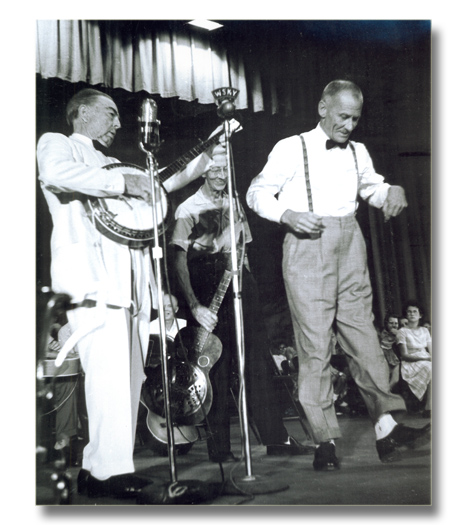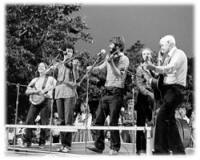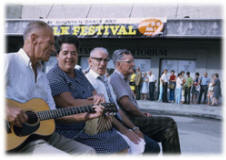Mountain Dance and Folk Festival
&
Shindig on the Green Collection
M2005.1.1-6, P2005.1, OS2005.1.1-4

Mountain Dance & Folk
Festival founder Bascom Lamar Lunsford (banjo), J.P. Fisher,
and Bill McElreath.
Photograh by Bill Lindsey.
|
Mountain
Dance & Folk Festival/Shindig on the Green - Official Home Site |
|
|
Title |
Mountain Dance and Folk Festival & Shindig on the Green Collection |
|
Creator |
Folk Heritage Committee |
|
Scope and Contents |
The Mountain Dance and Folk Festival (MDFF) is the nation's oldest folk festival. It grew out of the Rhododendron Festival and by 1930 it was an independent festival in Asheville, North Carolina. Today the annual Mountain Dance and Folk Festival continues to feature musicians and dancers who characterize the music and dance of the Southern Appalachian region. This collection documents the Mountain Dance and Folk Festival and its subsidiary entertainment venue, the Shindig on the Green. The Folk Heritage Committee, a subcommittee of the Asheville Chamber of Commerce, is the governing organization charged with the management of the Festival and of the Shindig on the Green and the records in this collection were donated by that agency. This collection documents the activity of the Mountain Dance and Folk Festival and from the late 1930's to the present, with most of the records falling within the period from the early 1960's forward. The Shindig on the Green was created in the 1970's. The very early history of the Mountain Dance and Folk Festival is housed in the Southern Appalachian Archives at Mars Hill University and in various private collections. Some early records and correspondence is included in this collection at UNCA. The bulk of the material centers on the promotional efforts of the two entertainment venues, and the largest body of material is the visual material that grew out of the marketing efforts of the Folk Heritage Committee and the Asheville Chamber of Commerce. The photographic images, posters, programs, ephemera, and objects such as award cups, plaques, and framed awards are largely concentrated on the 1970's through the 1980's and depict many of the events and performers of the Mountain Dance and Folk Festival and the Shindig on the Green. A total of 1.037 photographs, slides, pamphlets, and flyers have been digitized and can be viewed in the Mountain Dance and Folk Festival section of the Southern Appalachian Digital Collections website. The collection does not contain significant audio or video material from the Mountain Dance and Folk Festival. Scholars interested in such material should consult the Smithsonian Folkways recordings and the Library of Congress Archive of Folk Culture, American Folklife Center or the Bascom Lamar Lunsford archive at Mars Hill University. Material will continue to be added to this collection as it becomes available. The large holdings at Mars Hill University representing the Bascom Lamar Lunsford archive is central to an understanding of the Mountain Dance and Folk Festival and UNCA will continue to work with Mars Hill to encourage development of the best electronic access for scholars and for those interested in the history of the Festival and the Shindig on the Green. UNCA invites the identification of additional materials held in private collections that may relate to the history of the Mountain Dance and Folk Festival. We also welcome the identification of individual musicians and dancers depicted in the many images contained in this collection. Contact speccoll@unca.edu < |
|
Publisher |
D.H. Ramsey Library, Special Collections, University of North Carolina at Asheville 28804 |
|
Contributor |
North Carolina Humanities Council |
|
Date |
2005-05-01 |
|
Type |
Collection ; Text ; Photographs |
|
Extent |
18 linear feet |
|
Digitized Images |
Mountain Dance and Folk Festival photograph collection, part of the Southern Appalachian Digital Collections website. |
|
Source |
M2005.1.1-6, P2005.1 D.H. Ramsey Library Manuscript Collections |
|
Language |
English |
|
Coverage |
1928 - present ; Asheville, NC |
|
Rights |
Restrictions apply. Copyright retained by the Folk Heritage Committee, whose permission must be obtained prior to the publication of any material from the collection. Any display, publication, or public use must credit the D. H. Ramsey Library, Special Collections, University of North Carolina. |
|
Acquisition |
2005-03-10 ; Additional materials donated by Glenn Bannerman, January 17, 2012. |
|
Citation |
[Identification of item] Mountain Dance & Folk Festival & Shindig on the Green Collection, D.H. Ramsey Library, Special Collections, University of North Carolina at Asheville 28804 |
|
Processed by |
David Sobie, 2005 ; Helen Wykle, 2005 ; 2006 ; Matthew Farrell, 2009 ; 2010 ; HW 2012; Gene Hyde, 2014 |
|
Chronology: |
|
|
Historical Context "For forty-six years I've never had a written program, never had a piece of paper in my hand. I know the fellers, knew what they played, knew how well they did it, you see," so said Bascom Lamar Lunsford in a 1974 interview with Southern Exposure magazine. It was his vision of authentic and honest music along with his organizational wizardry that led to the first performance of what would later become known as the Mountain Dance and Folk Festival and which, some years following, inspired the annual Shindig on the Green. The Rhododendron Festival staged by the Asheville Chamber of Commerce had for many years held a parade, arts and crafts displays, and even a beautiful baby contest. It was Bascom Lamar Lunsford who developed the music and dance to accompany the popular festival. By 1930, in the early years of the Depression, the music and dance events had eclipsed the parent festival and the Mountain Dance and Folk Festival was launched as an independent event. While the Rhododendron Festival continued its programs until the late 1930's it was abandoned during the difficult years of WWII and was never re-vitalized. The Mountain Dance and Folk Festival not only thrived during the war years, it grew in popularity and stature. |
|
|
Bascom Lamar Lunsford was born in Mars Hill, North Carolina in 1882
on the campus of Mars Hill University. He trained at the college and also
learned how to pick the banjo and to have a deep appreciation of the
mountain ballad. He became a lawyer but he eventually returned to his
first calling, music. As a musician, his fame spread
and he performed for Franklin Roosevelt at the White House, for King
George VI and Queen Elizabeth and for other notables. His many
recordings were collected by Columbia University in 1935 and the Library
of Congress in 1949, and recordings are aviallable from Smithsonian Folkways Recordings, the Library of Congress's American Folklife Center, and in the Southern Appalachian Archives at Mars Hill University. His interest in
preserving the mountain heritage and in performing authentic mountain
music is seminal to the development of the Mountain Dance and Folk
Festival. His legacy also continues in another festival he and
pharmacist Ed Howard created in 1967, called the
Bascom Lamar Lunsford
Festival. Held annually at Mars Hill College in October, the
festival celebrates music, dance and crafts of the Southern
Appalachians. But, unlike the Mountain Dance and Folk Festival, the Mars
Hill Lunsford Festival does not promote competition, but emphasizes the
learning of mountain music and folk ways. Today both festivals feed into
a stream of cultural awareness that has helped the region to become
widely acknowledged as the center of Southern Appalachian music
and dance. Today many of the nations musicians, songwriters, song collectors,
and others with an interest in Appalachian culture, come to
Asheville and to Mars Hill to gather creative inspiration and none leave
without an introduction to Bascom Lamar Lunsford.
Asheville, a small town in the Southern
Appalachians of western North Carolina soon became recognized as a center for
Southern Mountain folksongs and for string music. Entertainers and
collectors of folk music such as Fiddlin' Bill Hensley,
Artus
Moser, Aunt Samantha Bumgarner, Bill McElreath, Red Parham, and
others were soon joined by "outsiders" like Pete Seeger, George
Pegram, Plez Mobley, Roger Sprung and others. "Outsiders" had a
difficult go of it in the early years of the festival, as Lunsford
wanted the festival to represent only the talent of "Native" artists but
the inclusion of "outsiders" soon became recognized as a strength of the
Festival.
The phrase "Along about sundown," often
associated with the Festival,
In the 1970's the Folk Heritage Committee, comprised of performers, the Festival Director, and other community members, was charged with the selection of musicians, singers, story-tellers, and dancers for the Festival. They quickly realized that the many jam-sessions were rich in new talent and they institutionalized these impromptu gatherings and called the "jam" Shindig on the Green.
Originally, the Shindig musicians gathered in the Westgate Shopping
Center where they played banjo, guitar and other musical instruments,
and tried out
Bascom Lamar Lunsford died September 4, 1973, but his legacy can be traced in the many musicians who have moved up through the friendly rigor of the Mountain Dance and Folk Festival. *See the Folk Heritage Committee 2002 publication, Along About Sundown ... 1928-2002, for the expanded history of the Festival and Shindig on the Green. |
|
| Bibliography | |
| Series | |
| 1 | Folk Heritage Committee organizational papers |
| 2 | Correspondence |
| 3 | Financial documents |
| 4 | Promotional documents |
| 5 | Legal documents |
| 6 | Planning and organizational documents |
| 7 | Printed materials ; Digitized selection 1 and 2 |
| 8 | Publications |
| 9 | Newspaper Clippings |
| 10 | Lunsford Primary Documents |
| 11 | Awards, plaques, and realia |
| 12 | Audio recordings |
| 13 | Video recordings |
|
14 |
Photographs - Mountain Dance and Folk Festival and Shindig on the Green Over 1,300 images digitized from 35 mm slides, negatives, and prints ranging from 1963 to 2001. |
| 15 |
Glenn Bannerman Donation (January 2012)
|


 was
coined by Lunsford to give an air of informality to the events of
the Festival. Rather than subject the musicians, dancers and
audience to a tightly controlled time-table, he would give the
starting time for the main events of the festival as "Along about
sundown." It was this folksy and informal style that could be found in the
many "jamming" sessions that often sprang up at the Festival. Also,
it was in these spontaneous sessions that many new dancers and
musicians stretched their winged feet and picked their fingers raw
and started on the long road to recognition. It was their enthusiasm for
music that also gave rise to another Asheville tradition, the
so-called "Shindig on the Green."
was
coined by Lunsford to give an air of informality to the events of
the Festival. Rather than subject the musicians, dancers and
audience to a tightly controlled time-table, he would give the
starting time for the main events of the festival as "Along about
sundown." It was this folksy and informal style that could be found in the
many "jamming" sessions that often sprang up at the Festival. Also,
it was in these spontaneous sessions that many new dancers and
musicians stretched their winged feet and picked their fingers raw
and started on the long road to recognition. It was their enthusiasm for
music that also gave rise to another Asheville tradition, the
so-called "Shindig on the Green." new
songs, and re-worked old ones. It was in these informal gatherings that
many musicians and an occasional "clogger" or story-teller was
prompted to give up their "day job" for the world of entertainment.
Today the summer evening Saturday "Shindigs" are still being
held and they provide a free and informal gathering place for
locals, tourists and folk music aficionados from around the country.
Currently the Shindig on the Green has moved to Martin Luther Park
while its traditional location on Pack Square in
front of the City and County buildings, is re-landscaped and shaped
into a more expansive community park. Where Shindig gathers on a Saturday evening
in the summer
the foot-tapping audience may number into the thousands and in that
audience new musicians are born.
new
songs, and re-worked old ones. It was in these informal gatherings that
many musicians and an occasional "clogger" or story-teller was
prompted to give up their "day job" for the world of entertainment.
Today the summer evening Saturday "Shindigs" are still being
held and they provide a free and informal gathering place for
locals, tourists and folk music aficionados from around the country.
Currently the Shindig on the Green has moved to Martin Luther Park
while its traditional location on Pack Square in
front of the City and County buildings, is re-landscaped and shaped
into a more expansive community park. Where Shindig gathers on a Saturday evening
in the summer
the foot-tapping audience may number into the thousands and in that
audience new musicians are born.  Not
only did Lunsford require his early musicians in the Festival to be
clean-living natives, he held equal standards for the dancers of the
Mountain Dance and Folk Festival. Clogging, a popular dance style in
the mountains was institutionalized at the Festival. Many believe it
was through this Festival that the idea of clog-dance teams was
born. These teams still flourish throughout the Southern
Appalachians and, indeed, throughout the country. For Lunsford, an
"insider" was not just a geographic locator, it was a stamp of
authenticity and personal integrity.
Not
only did Lunsford require his early musicians in the Festival to be
clean-living natives, he held equal standards for the dancers of the
Mountain Dance and Folk Festival. Clogging, a popular dance style in
the mountains was institutionalized at the Festival. Many believe it
was through this Festival that the idea of clog-dance teams was
born. These teams still flourish throughout the Southern
Appalachians and, indeed, throughout the country. For Lunsford, an
"insider" was not just a geographic locator, it was a stamp of
authenticity and personal integrity.